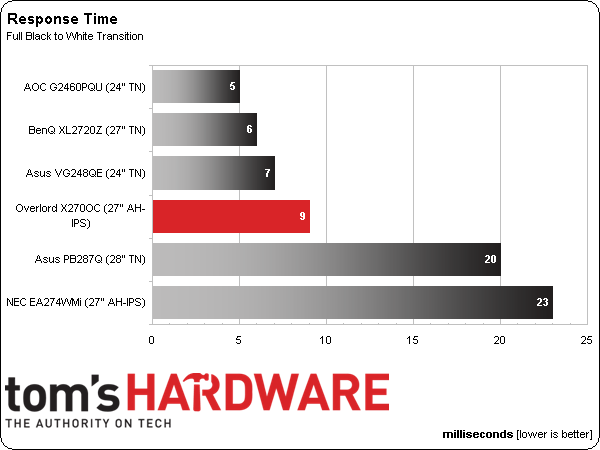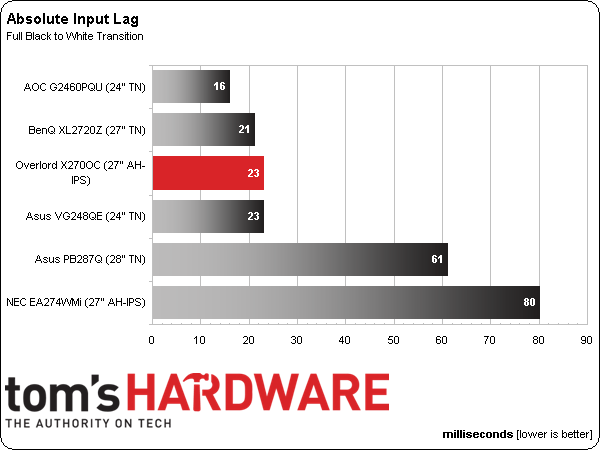Overlord Tempest X270OC, 27" 120 Hz IPS Gaming Monitor Review
After many reader requests to review Overlord’s 120 Hz 27-inch QHD monitor, we finally got a brand new X270OC in our labs. It’s the only IPS screen we know of that can exceed a 60 Hz refresh rate. We run it through our benchmark and usability test suite.
Results: Pixel Response And Input Lag
To perform these tests, we use a high-speed camera that shoots at 1000 frames per second. Analyzing the video frame-by-frame allows us to observe the exact time it takes to go from a zero-percent signal to a 100% white field.
We had to do things differently for this review since our pattern generator maxes out at 60 Hz. So, we filmed a mouse movement that triggers the field pattern’s appearance. Since this is less precise than using the generator, we averaged five measurements.
Here is the screen draw result:
At 120 Hz, the draw time is about two-thirds faster than a typical IPS panel’s time of 25 milliseconds. Needless to say, the reduction in motion blur is more than subtle. We ran through many of the tests at blurbusters.com and saw clear improvements in all of them when running at 120 Hz versus 60.
Here are the lag results:
All of the high-refresh displays we’ve tested, including the Tempest, demonstrate extremely low input lag. Consider the advantages enjoyed by the AOC, BenQ, and Asus VG248QE. They employ TN panels with 6-bit/FRC color depth. And they’re only driving a resolution of 1920x1080. The Tempest is IPS. It’s a full 8-bit panel. And it’s refreshing 44 percent more pixels. Now that’s impressive. A price tag of $450 is just icing on the cake.
Get Tom's Hardware's best news and in-depth reviews, straight to your inbox.
Current page: Results: Pixel Response And Input Lag
Prev Page Results: Viewing Angles and Uniformity Next Page Overlord’s Tempest X270OC Satisfies The Speed And Resolution Obsession
Christian Eberle is a Contributing Editor for Tom's Hardware US. He's a veteran reviewer of A/V equipment, specializing in monitors. Christian began his obsession with tech when he built his first PC in 1991, a 286 running DOS 3.0 at a blazing 12MHz. In 2006, he undertook training from the Imaging Science Foundation in video calibration and testing and thus started a passion for precise imaging that persists to this day. He is also a professional musician with a degree from the New England Conservatory as a classical bassoonist which he used to good effect as a performer with the West Point Army Band from 1987 to 2013. He enjoys watching movies and listening to high-end audio in his custom-built home theater and can be seen riding trails near his home on a race-ready ICE VTX recumbent trike. Christian enjoys the endless summer in Florida where he lives with his wife and Chihuahua and plays with orchestras around the state.
-
oudmaster the price is interesting with these specs !Reply
any idea if there will be a similar monitor spec but 4k resolution ?
thanks, -
oudmaster the price is interesting with these specs !Reply
any idea if there will be a similar monitor spec but 4k resolution ?
thanks, -
wtfxxxgp Crickey me...this is a monitor of note it seems! At that price point, I find it incredible. Well done to Overlord! The only issue I have now is... will the price increase as a result of all the buzz this will generate? This is probably going to be my next monitor, depending on exchange rates...Reply -
Swiperd3 Driving QHD to 120 FPS at the max graphics detail is sure as hell will require A LOT of horsepower. Will TOP-SLI/CF-x2 be enough for modern FPS games?Reply -
Traciatim Wow, you get this with one of the variable sync techs and you have yourself one fantastic monitor.Reply -
Reaver192 Yeah, I've been waiting fir this for too long. I wanted one of these months ago but they have been out of stock. Such a sweet dealReply

